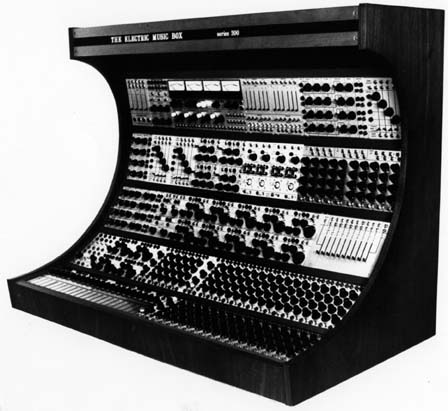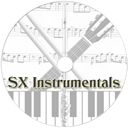Description | When Buchla started to expand itself into markets other than Schools and Universities such as performing musicians and sound designers, they came out with the far more advanced 200-series modules (1970-78). They dubbed it, "The Electric Music Box". The 200's ability to interface its voltage controlled analog circuitry with digital computers really opened the door to complex programming and control not yet seen. They also introduced a color-coded patch-cord system to simplify patching and to provide an easy view of what's going where. It first came out as another modular system encased in a large wood cabinet, as pictured above. The flat touch-plate keyboard typically used by Buchla was also found here.
Modules for the Buchla Series 200
- 202 Portable case
- 203-8 Portable case, briefcase-style (similar to EMS Synthi A)
- 204 Quad Spatial Director - Voltage controlled quadraphonic distributor for determining the spatial location of sounds with pan pots or externally applied voltages. Monitor switches and voltage controlled attenuators are included.
- 205 Matrix Mixer - two 5 x 4 mixers with cross-routing possible
- 206 Dual Mixer - two 3-channel mixers switchable between pre/post fade
- 207 Mixer/Preamplifier - six-channel stereo mixer with voltage-controlled panning
- 208 Stored Program Sound Source - This module is basically a complete synthesizer. It includes a VCO with rectangle, triangle and sawtooth waveforms. It allowed voltage control of pitch, timbre, and wave shape. It contained two low-pass VCFs, a five-step by four-output sequencer, an LFO, a voltage controlled ASD envelope generator, a voltage controlled "pulser", and a random voltage generator. It also had a plug-in card patch memory system, headphone jack, external mic input with an envelope follower, reverb, and separate output controls for mix, reverb, monitor, and final level.
- 212 Dodecamodule
- 214A Power supply
- 215 Power supply
- 215A Power supply
- 216 Touch Control - Voltage Source capacitive keyboard similar to the earlier 112
- 217 Touch Keyboard - 2 1/2-octave, 29-note (C-E) capacitance "keyboard" with preset pitch/voltage shifter, portamento, pressure and pulse outputs (gates).
- 218 Touch Keyboard - 2 1/2-octave, 29-note (C-E) capacitance "keyboard" with preset pitch/voltage shifter, portamento, pressure and pulse outputs (gates).
- 219 Touch Keyboard - 17 note electronic keyboard with both tunable and equal interval outputs. A combination of four separate touch sensitive controllers, each with a variety of pressure and position activated outputs.
- 221 Kinaesthetic Input Port - This controller module features a capacitive keyboard with frets and slightly raised keys and a 32-note control-voltage section using lateral key pressure to control portamento and pitch bend. Other sections control presets, octave shifting, and two joystick outputs. The 221 also featured a buffered digital output.
- 226 Quadraphonic Monitor/Interface - For monitoring, interfacing, and final program formatting in four-channel systems. Built-in provisions for quad mixing, duplications, and overdubbing simplify the manipulation of quadraphonic material.
- 227 System Interface - EQ, pan, reverb, and two 4-channel mixers. One mixer has four inputs with EQ (bass and treble), FX send, pan and routing. The other is a simple 4-channel line mixer. The 227 also has four VU meters, four monitor outputs, as well as the main signal output.
- 230 Triple Envelope Follower - Three envelope followers with a variable decay time setting of 0.1 seconds to 5 seconds.
- 232 Frequency Detector
- 237 37-key Polyphonic Keyboard
- 238 61-key Polyphonic Keyboard
- 242 Programmable Pulser - This is a miniature 12-position X 4 sequencer that uses a pin matrix. It has little LEDs to show position within the sequence.
- 245 Sequential Voltage Source - an analogue memory for storing and retrieving control voltages. It includes an electronically separate pulse generator with voltage controlled period and pulse length (duty cycle). The Model 245 produces up to 5 programmed voltages at each of four outputs.
- 246 Sequential Voltage Source - The Sequential Voltage Source is an analogue memory for storing and retrieving control voltages. It includes an electronically separate pulse generator with voltage controlled period and pulse length (duty cycle). The Model 246 produces up to 16 programmed voltages at each of four outputs.
- 248 Multiple Arbitrary Function Generator - This is an elaborate 16-step X 2-output envelope or sequence controller, with 16 steps variable from 1ms to 120 seconds, all independent and accessible to voltage control.
- 248-1606 Multiple Arbitrary Function generator - This is an elaborate 16-step X 6-output envelope or sequence controller, with 16 steps variable from 1ms to 120 seconds, all independent and accessible to voltage control.
- 248-3206 Multiple Arbitrary Function generator - This is an elaborate 32-step X 6-output envelope or sequence controller, with 32 steps variable from 1ms to 120 seconds, all independent and accessible to voltage control.
- 248-3210 Multiple Arbitrary Function generator - This is an elaborate 32-step X 10-output envelope or sequence controller, with 32 steps variable from 1ms to 120 seconds, all independent and accessible to voltage control.
- 256 Dual Control Voltage Adder Model - Allows several control voltages to simultaneously affect a single parameter. Up to four applied voltages can be scaled and added (or subtracted) to (or from) an internally generated offset voltage.
- 257 Dual Voltage Control Processor - This module is for adding, subtracting, scaling, inverting, or multiplying voltages.
- 258 Dual Oscillator - Both have frequency settings from 5Hz to 20kHz. VCO1 features a continuously variable waveform from sine to sawtooth. VCO2 features a continuously variable waveform from sine to square wave
- 259 Programmable Complex Waveform Generator - This is a dual oscillator featuring computer control and a tuning interface. VCO1 has a frequency range of 27Hz to 7Khz. It features sync, and voltage control of "harmonic intensity", "order", and "symmetry". VCO2 has a frequency range of .25Hz to 7Khz, thus making it a good choice for an LFO.
- 264 Quad Sample-And-Hold/Polyphonic Adaptor
- 265 Source of Uncertainty - This module contains two continuously varying random voltages, two sample-and-hold voltages, and three types of noise.
- 266 Source of Uncertainty - This module contains two continuously varying random voltages, four sample-and-hold voltages, and three types of noise.
- 270 Quad Preamplifier - four mic/instrument inputs
- 275 Dual Rever / Equalizer - Two electronically separate units for reverberating and equalizing audio signals.
- 280 Quad Envelope Generator - This modules contains four simple envelope generators. Attack and decay times are variable between 1ms and 10 seconds.
- 281 Quad Envelope Generator - This modules is a reworked version of the 280. It also contains four simple envelope generators. Attack and decay times are variable between 1ms and 10 seconds.
- 284 Quad Envelope Generator - Adds voltage control and variable delay and duration times to the capabilities of the Model 280.
- 285 Frequency Shifter / Balanced Modulator - This module contains a frequency shifter with external or internal control-voltage, and a balanced modulator which is variable up to full ring modulation.
- 291 Dual VCF - Two voltage-controlled bandpass filters with a frequency range of 30Hz to 15kHz. Band width is variable between 1 semitone and one octave. It features voltage control of the center frequency as well as the bandwidth. The filters have resonance and external modulation controls.
- 292 Quad VC Lo-pass Gate - This module contains four VCFs with voltage controlled panning.
- 294 Four Channel Filter - This module contains four 20dB/octave filters positioned at crossovers of 250Hz, 1kHz, and 4kHz.
- 295 Ten Channel Filter - This is a comb filter featuring gain controls on each of its ten frequency bands.
- 296 Programmable Spectral Processor - This is a 16-band 6-pole voltage-controlled filter with a computer interface. It could be configured as two 8-band filters. This is a important module used in making a vocoder.
|



